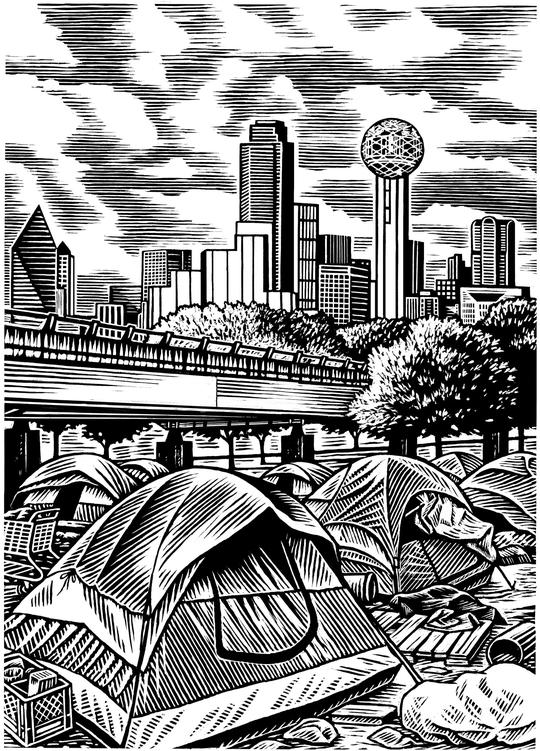God Save Texas: A Journey Into the Soul of the Lone Star State (18 page)
Read God Save Texas: A Journey Into the Soul of the Lone Star State Online
Authors: Lawrence Wright
Tags: #politics


John Burnett, is a reporter for NPR. He and Hawk Mendenhall, the station manager for KUT, our local NPR affiliate, literally embody FM Texas. They have been cycling across the state to raise money for charity. In 2015, they rode from Brownsville, at the very bottom of the horn-shaped tip of the state, to the Red River on the border of Oklahoma, logging 734 miles. That’s farther than from Charlotte, North Carolina, to New York. A year later, they pedaled from Sunland Park, New Mexico, just west of El Paso, to Merryville, Louisiana, just across the Sabine River, a total of 1,113 miles over seventeen days, mostly on two-lane back roads through the small towns of the state. West Texas was one long stretch of headwinds and road-killed jackrabbits, through counties that are larger than some New England states. Once they passed Navasota, the South began. “Suddenly, the waitresses began calling us ‘honey’ and ‘sweetheart.’ We saw a lot of Confederate flags,” John said. “The state hasn’t changed so much as it has become more like ‘Texas’—the stereotype—than it’s ever been. There are so many more barbecue joints, more gun shops and target ranges. But one thing that hasn’t changed is the deep, abiding friendliness.”
“We’re riding across Texas on our bikes,” John said.
“Why the hell would you do that?”
John explained that they were raising money to buy bicycles and books for schoolchildren in Kenya.
The cowboys returned to the pool table, but as John and Hawk were leaving, one of them stuffed two $20 bills in John’s pocket. “Give this to them kids in Africa,” he said.
Friendliness is a sort of mandate in the state. The state motto is Friendship. Highway signs enjoin us to Drive Friendly. And indeed, if you are traveling on a two-lane road and see a vehicle coming from the opposite direction, the protocol is to raise an index finger about an inch off the rim of the steering wheel in a laconic salute. Steve’s brother-in-law says he decided to move to Texas when he saw people thanking the bus driver as they disembarked.
Texas advertises itself in travel magazines as “a whole other country”—an echo of its decade of independence as a republic—and it still loves to think of itself as an independent entity. It is certainly big enough to stand alone. “Texas is more than five times the size of New York state,” John Bainbridge marveled in 1961, and “bigger than any country in Europe except Russia.” I still recall the gloom that settled over Texas in January 1959, when Alaska joined the Union. We had to change the lyrics of our kitschy state song:
The Republic of Texas was far larger than the present entity, taking in half of New Mexico, portions of Oklahoma, Kansas, Colorado, and southern Wyoming. We have stopped mourning the loss of all those mountains and trout streams, but the imaginative lure of a distant Texan Camelot seems only to get stronger. “When we came into the nation in 1845, we were a republic,” Rick Perry informed a group of visitors when he was still governor. “And one of the deals was, we can leave any time we want. So, we’re kind of thinking about that again.” Every schoolchild learns in the seventh grade, while taking the mandatory Texas history class, that when Texas entered the Union it came with a prenuptial agreement: the possibility of splitting itself into five states—with ten senators!—any time it chooses. It does not have the right to secede, however.
Texas isn’t actually alone in its longing to break free of the federal grip. A 2014 Reuters poll found that nearly a fourth of all Americans would like to see their own state leave the Union, about the same as the number of Texans who feel that way. After the Trump victory, secession fever suddenly jumped to California. We recently learned that a lot of secessionist fever was being fanned by Russian trolls on Facebook. The largest secessionist page, “Heart of Texas,” was among the Russian propaganda sites that Facebook shut down; it had more followers than the official Texas Democrat and Texas Republican party Facebook pages combined.
And yet, it’s a strange, dysfunctional marriage between Texas and the United States. Texas is at once the most super-American of states and the most indigestible. A 2011 MyLife.com poll found that five of the ten most patriotic cities in America—measured by the percentage of the population in the armed forces, veteran spending, community and social service workers, and fireworks popularity on the Fourth of July—were in Texas. At the same time, there is a defiant sense of apartness and a grudging feeling of being bossed around. When our current governor, Greg Abbott, was the Texas attorney general, he described his job this way: “I go into the office in the morning, I sue Barack Obama, and then I go home.” As governor, under Trump, with even less to do, he advocates a constitutional convention to consider various amendments that would transfer power from the federal government to the states, which his predecessor Rick Perry once called the “lavatories of democracy.” A recent law would create the Texas Bullion Depository—“the first state-level facility of its kind in the nation,” Governor Abbott tweeted when he signed the bill, adding, “California may be the golden state, but Texans deserve to keep their gold in-state!”
The depository was seen as a step toward putting Texas on a gold standard if and when we divorce ourselves from the United States. Actually, most of the billion dollars in gold that the state believes belongs in Texas is owned by the University of Texas Investment Management Company ($861 million!), which has no interest in taking that out of an HSBC bank vault in New York City.
Sanford Levinson, a distinguished law professor at UT, compares Texas to Scotland—another formerly independent nation that has never entirely accepted the loss of its independence. The difference is that Scotland actually can secede, if its voters choose to; for Texas, that battle has long since been lost. The only way Texit might work is through a constitutional amendment that would allow American voters to say: Just go.

n July 7, 2016, hundreds of marchers on a hot summer night in Dallas were protesting the police slayings of black men in Minnesota and Louisiana. Two days before, a video had surfaced that showed two white cops in Baton Rouge shooting Alton Sterling, 37, who was already pinned to the ground when one of the officers cried out, “He’s got a gun!” They shot him six times. Sterling did have a loaded .38 in his pocket. Another video appeared the next day, streaming on Facebook Live. When the video begins, Philando Castile, 32, has already been shot. He had been pulled over by police in a suburb of St. Paul for a broken taillight. When he voluntarily disclosed, as required by law, that he had a license to carry a gun, and then reached for his wallet, one of the officers shot him four times.
“You told him to get his ID, sir, his driver’s license,” she says.
Castile falls silent. “Please don’t tell me that my boyfriend went just like that,” Reynolds says. Her four-year-old daughter is in the backseat.
“Keep your hands where you are!” the cop says huskily.
“Yes, I will, sir, I’ll keep my hands where they are. Please don’t tell me this, Lord. Please, Jesus, don’t tell me that he’s gone.”
By now, a number of cops have raced to the scene. They are all holding weapons on Reynolds. They order her to get out of the car and walk backward toward them, then drop to her knees. They take the phone out of her hands and toss it on the ground, but it’s still recording, pointed at the sky and the electrical lines overhead, as she is handcuffed. “They threw my phone, Facebook,” Reynolds says, as an ambulance siren sounds in the background. A cop repeatedly screams, “Fuck! Fuck!” (The policeman who shot Castile, Jeronimo Yanez, was later acquitted of all charges against him.)
These two killings shook the country. A movement, Black Lives Matter, had sprung up in 2013, after the acquittal of George Zimmerman, the neighborhood watch captain who killed Trayvon Martin, an unarmed black teenager, in a gated community in Central Florida. Other police shootings caused the movement to spread and passions to rise.
There were protests against the killings all over the country, but Dallas was an inappropriate target for such a demonstration; in the last few years, under the leadership of its black police chief, David O. Brown, the murder rate was lower than it had been since 1930, and police shootings had dropped sharply, along with complaints about improper use of force. Although the police were undermanned and underpaid, the Dallas department had developed a national reputation for fair and nonviolent action. Indeed, during the march, some officers tweeted photographs of themselves standing with the marchers.
One could believe that if there was a way of healing the rift between police and African American communities, it was to be found in Dallas. More than anyone in the city, perhaps in the country, David Brown understood the pain that both the police and the black community were experiencing. On Father’s Day 2010, a few weeks after he had been sworn in as police chief, his own son, David Brown Jr., shot and killed two men, one of them a cop.
But perhaps Dallas is destined to shoulder the burden of certain tragedies that mark our path as a country. When the killer, Micah Johnson, opened fire during the Black Lives Matter march, he was only two blocks from Dealey Plaza, the site of Kennedy’s assassination. The echoes were unnerving. The wounded and slain were taken to Parkland Hospital, where the president had been pronounced dead. Lee Harvey Oswald and Micah Johnson were both military veterans with undistinguished records. Discontented with their inconsequential lives and angry at America, Oswald had turned to Marxism and Johnson to a black separatist movement called the New Black Panther Party, which is headquartered in Dallas. They were opportunists, trying to murder their way into history. Before killing Kennedy, Oswald had taken a shot at General Edwin Walker, a right-wing racist. Johnson had filled his house with bomb-making materials and must have been planning a bloody spectacle, but he hadn’t settled on a target. The month before he killed the police officers, Johnson had asked permission from organizers to bring guns to a protest rally against Donald Trump.

